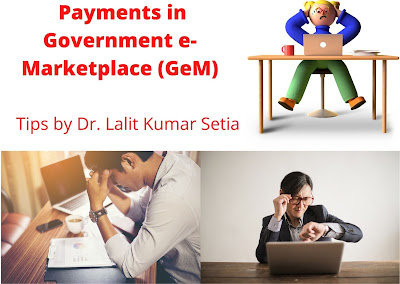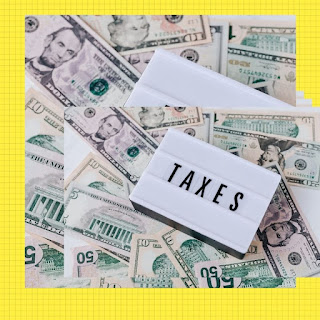Payments in Government e-Marketplace (GeM)
-Dr.
Lalit Kumar Setia
The
GeM buyers are usually notified in the login that the payments to sellers or
service providers are still payable. Most of the time, I receive queries
regarding practical problems in making payments of GeM purchases. This content,
I hope will help the readers to understand how payments are processed on the GeM
portal.
Approvals for purchases in GeM
In
Government, for each purchase, two approvals are generally sought i.e.
Administrative approval and financial approval. GeM also considers both the
approvals in the process at the initial stage of purchases by the Buyer. For getting
financial approval, there is a need to have a budget provision in a specific head
of budget during the financial year in which the purchase is required to be
done.
e-Signing of Contracts in GeM
The
sellers require a sanction order which is generated by the GeM portal, further, the
supply order is e-signed by the buyer. While making payment of a particular
purchase, the sanction order/supply order is always available to the user ‘payment
authority or DDO’ in the GeM portal.
Payment by DDO/PAO/PA
This
is the duty of the primary user to supervise the activities of secondary users as
per the rules of GeM. The Drawing and Disbursing Officer (DDO) or Principal
Accounts Officer (PAO) in GeM, is the secondary user for the organizations, who
opt for connecting PFMS in GeM for payment purposes, generally in the case of
departments. For organizations other than the Government department connected with
PFMS; the paying authority is responsible for making payments.
What to do if the amount is blocked or not provided due to Budget restrictions
In
Government, there are chances or practical problems that the amount is
sanctioned initially but at the time of payment, the specified budget head is
blocked to release the payment. In such circumstances, the participants are
curious to know the optimum solution.
The
sellers/service providers are bound with the terms and conditions of the
contract with the buyers. In case, the payment is delayed due to blocking of the budget head, the sellers/service providers expect amendment in the contract to
avoid the loss or cancellation of the contract if required. The GeM portal
automatically provides options to select, for making such decisions in the login
of DDO/PAO/Paying Authority.
Payment using Public Financial Management System (PFMS)
Within
10 days after generation of CRAC or deemed CRAC; the buyer prepares the ‘payment
advice’ and the GeM portal generates claims for payment. The same is available
when the DDO user login on GeM. The DDO generates the bill and forwards it to
the PAO/PA for payment of the purchase.
Payment Using other modes
In
Haryana and other state governments, the organizations are not connected with
PFMS. The payments can be made as in cases of purchases without using GeM.
However, if the payment is required to be made using direct payment in the bank
account of the seller/service provider; then the details can be entered in GeM's
online payment method. In cases when the buyer wants to make payment by using
any application such as e-Billing in Haryana; then also the payment can be
made. However, in such cases, it is required to ensure TDS or any other
deduction before making the payment. After making the payment, the details
should be entered in the PAO/PA login of GeM.
What to do if the bill is returned?
The
PAO/PA is responsible to ensure accurate payment to the seller/service
provider. In case, there are discrepancies in the purchase, the same may be pointed
out by the PAO/PA and the bill is returned (after taking approval of competent
authority) to the DDO (in case of PFMS) or Buyer (in case of organizations not
connected with PFMS).
Who is responsible for the delay in payment on GeM?
The
terms and conditions of GeM, states that there should be timely payment of
purchases to the seller/service provider. After generating CRAC, within 10 days
the payment should be made. For fixing the responsibility of delay in the
payment of Buyer or Consignee or DDO or PAO or PA; the time limit of 10 days is
further segregated as under:
Buyer
– 2 Working days
Concerned
DDO – 1 working day
Concerned
PAO/PA – 2 working days
In
case of return of Bill – 1 working day to DDO/Buyer
Again
concerned PAO/PA – 1 working day.
If
there are still discrepancies – 24 hours to sort out issues at a higher level.
In the entire process, a total of 10 calendar days (including holidays).
If
you still have any queries, then kindly raise your query in the comment box. All the
best!
*Copyright © 2021 Dr. Lalit Kumar. All rights reserved.
This article is written by Dr. Lalit Kumar Setia; a renowned author and trainer. He completed his Doctorate in Commerce from Kurukshetra University Kurukshetra and MBA in Information Technology from GJU, Hisar. He also wrote two books, 15 research papers, and organized more than 200 Training Courses during his working period since 2006 in Haryana Institute of Public Administration, Gurugram. The article was published on 28th September 2021 and last updated on 28th September 2021. The writer can be contacted on lalitkumarsetia@gmail.com
More Articles of Your Interest
https://drlalitsetia.blogspot.com/2021/09/how-does-unique-code-of-payee-work.html
https://drlalitsetia.blogspot.com/2021/09/pension-under-employees-provident-fund.html
https://leavesofprogress.blogspot.com/2021/09/parking-of-funds-and-personal-ledger.html






















